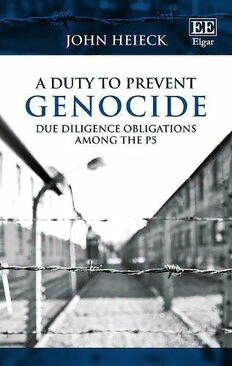
A Duty to Prevent Genocide: Due Diligence Obligations among the P5 PDF
Preview A Duty to Prevent Genocide: Due Diligence Obligations among the P5
JOBNAME:Heieck PAGE:1 SESS:2 OUTPUT:WedAug 109:24:062018 A Duty to Prevent Genocide ColumnsDesignXMLLtd / Job:Heieck-A_duty_to_prevent_genocide / Division:Prelims /Pg.Position:1/ Date:29/5 JOBNAME:Heieck PAGE:2 SESS:2 OUTPUT:WedAug 109:24:062018 For Kasia, and her devoted Sam ColumnsDesignXMLLtd / Job:Heieck-A_duty_to_prevent_genocide / Division:Prelims /Pg.Position:2/ Date:29/5 JOBNAME:Heieck PAGE:3 SESS:2 OUTPUT:WedAug 109:24:062018 A Duty to Prevent Genocide Due Diligence Obligations among the P5 John Heieck University of Kent, Brussels School of International Studies, UK Cheltenham,UK+Northampton,MA,USA ColumnsDesignXMLLtd / Job:Heieck-A_duty_to_prevent_genocide / Division:Prelims /Pg.Position:1/ Date:29/5 ©JohnHeieck2018 Allrightsreserved.Nopartofthispublicationmaybereproduced,storedina retrievalsystemortransmittedinanyformorbyanymeans,electronic,mechanical orphotocopying,recording,orotherwisewithoutthepriorpermissionofthe publisher. Publishedby EdwardElgarPublishingLimited TheLypiatts 15LansdownRoad Cheltenham GlosGL502JA UK EdwardElgarPublishing,Inc. WilliamPrattHouse 9DeweyCourt Northampton Massachusetts01060 USA Acataloguerecordforthisbook isavailablefromtheBritishLibrary LibraryofCongressControlNumber:2018935766 Thisbookisavailableelectronicallyinthe Lawsubjectcollection DOI10.4337/9781788117715 ISBN9781788117708(cased) ISBN9781788117715(eBook) TypesetbyColumnsDesignXMLLtd,Reading Contents in brief Acknowledgements viii Introduction 1 1 The P5’s duty to prevent genocide under the Genocide Convention 13 2 The P5’s duty to prevent genocide under customary international law 72 3 The conflict between the P5’s duty to prevent genocide and the P5’s rights and duties under conventional and customary international law 119 4 Resolving the conflict between the P5’s duty to prevent genocide and the P5’s rights and duties under conventional and customary law 166 Conclusion 207 Bibliography 217 Index 241 v Full contents Acknowledgements viii Introduction 1 1 The P5’s duty to prevent genocide under the Genocide Convention 13 1 Introduction 13 2 The Genocide Convention 14 3 The Bosnian Genocide case 14 4 The scope and breach of the P5’s duty to prevent genocide under the Genocide Convention 49 5 Conclusion 70 2 The P5’s duty to prevent genocide under customary international law 72 1 Introduction 72 2 Customary international law in general 73 3 The test for custom in case law – uncontroverted opinio juris – and its application to the duty to prevent genocide 76 4 Conclusion 117 3 The conflict between the P5’s duty to prevent genocide and the P5’s rights and duties under conventional and customary international law 119 1 Introduction 119 2 Conflict within the Security Council: The P5’s duty to prevent genocide and the P5’s rights underArticles 39, 41, 42, and 27(3) of the UN Charter 123 3 Conflict without the Security Council: The P5’s duty to prevent genocide and the P5’s duty not to use force under conventional and customary law 157 4 Conclusion 165 4 Resolving the conflict between the P5’s duty to prevent genocide and the P5’s rights and duties under conventional and customary law 166 vi Fullcontents vii 1 Introduction 166 2 Article 103 of the UN Charter 167 3 Jus Cogens norms 173 4 Erga Omnes obligations 202 5 Conclusion 206 Conclusion 207 1 Summary analysis 207 2 Parting thoughts 215 Bibliography 217 Index 241 Acknowledgements This book would not have been possible without the guidance, encour- agement, and constructive criticism of Teresa Cabrita,YutakaArai, Harm Schepel, Bill Bowring, Luis Eslava, Nikolas Rajkovic, Maïté Van Regemorter, and Kevin Jon Heller. I cannot thank you enough. Additional thanks are owed to my parents, John and Sheila Heieck, to my family, Ted Heieck and Rachel Siecke, and to my friends, Michelle Reyes Milk, Michele Simonato, Jake Slosser, Moritz Pieper, Octavius Pinkard, Inez Summers, Olya Burlyuk, Ogˇuzhan Keskin, Andrea Varga, Salvatore Dziekan, Tom Casier, Tugba Basaran, Amanda Klekowski von Koppenfels, Robert Heinsch, Freya Baetens, Collin Mangrum, Michael Kelly, Patrick Borchers, Shane Osborn, and Chuck Hagel, for their support over the years. Lastly, I would like to thank Ben Booth, Amber Watts, Jennifer Lee, Catherine Cumming, Jane Bayliss, and the entire team at Edward Elgar. I could not have asked for a better publishing experience. viii Introduction Since the SecondWorldWar, the prohibition of the use of force has been the cornerstone upon which the entire edifice of the United Nations (UN) peace and security system has been built. It was designed specifically to outlaw the use of force as a means by which states might resolve their international disputes. In its stead, the following system of the use of force was put in place: states may engage in force only if (a) they are acting in self-defense pursuant toArticle 51 of the Charter of the United Nations (UN Charter),1 or (b) they have been authorized by the Security Council to use force under Chapter VII of the UN Charter. There are no other exceptions available in the UN system. The goal of such a system was simple: in order to avoid a devastating third world war, the jus ad bellum in the post-war era would be tightly constrained. During the building of the UN system, the law of genocide was undergoing a contemporaneous construction. Responding to the atrocities of the Holocaust, the law of genocide culminated in the drafting of the Convention on the Prevention and Punishment of the Crime of Genocide (Genocide Convention).2 Article I of the Genocide Convention provided for the prohibition, prevention, and punishment of the crime of genocide. However, due to the political deadlock between the United States (US) and the Union of Soviet Socialist Republics (USSR) during the Cold War, the operationalization of both the UN system and the Genocide Convention became frozen.3 1 Charter of the United Nations (1945), 892 UNTS 119 (1945). 2 Convention on the Prevention and Punishment of the Crime of Genocide (1948), 78 UNTS 277 (1951) [hereinafter Genocide Convention]. 3 For a critical historical analysis of the US and the USSR’s approaches to the drafting of the Genocide Convention, see A. WEISS-WENDT, ‘The Soviet Union and the Genocide Convention: An Exercise in Cold War Politics’ in A. BIEN´CZYK-MISSALA and S. DUBSKI (eds.), Rafał Lemkin: A Hero of Human- kind, The Polish Institute of InternationalAffairs,Warsaw 2010, at 179–94, esp. 179 (opining that: ‘The ideological adversaries [i.e. the United States and Soviet Union] worked hard to install safeguards that would make it difficult, if not utterly impossible, to use the Genocide Convention as legal blackmail. In effect, these efforts rendered the Genocide Convention dysfunctional.’). 1
